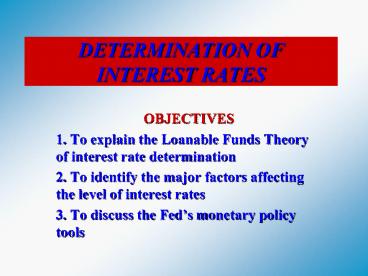DETERMINATION OF INTEREST RATES
1 / 13
Title:
DETERMINATION OF INTEREST RATES
Description:
Title: CHAPTER TWO Author: Dr. David Durst Last modified by: Bentley College Created Date: 6/17/1995 11:31:02 PM Document presentation format: On-screen Show – PowerPoint PPT presentation
Number of Views:11
Avg rating:3.0/5.0
Title: DETERMINATION OF INTEREST RATES
1
DETERMINATION OF INTEREST RATES
- OBJECTIVES
- 1. To explain the Loanable Funds Theory of
interest rate determination - 2. To identify the major factors affecting the
level of interest rates - 3. To discuss the Feds monetary policy tools
2
LOANABLE FUNDS THEORY (LFT)
- One of several theories of how the general level
of interest rates is determined - Interest rates determined by demand and supply
for loanable funds - However, as economic and other factors also
influence the demand and/or supply level they do
impact on interest rate
2
3
DEMAND FOR LOANABLE FUNDS
- Households borrow for consumption (auto,
mortgage, etc) - Businesses borrow to invest in plant and
machinery - Governments borrow to cover budget deficits
(arising from expenditure exceeding revenues) - Foreign governments and businesses borrow in
larger, efficient U.S. financial markets, with
lower rates - Government demand is interest inelastic, but all
other demand curves (on aggregate) slope
downwards - Are all components of aggregate consumer spending
sensitive to interest rates?
3
4
SUPPLY OF LOANABLE FUNDS
- Households are the major suppliers of funds
- Households save from their income to increase
future consumption - Rate of savings depends on their preferences for
current vs. future consumption, level of income,
amount of wealth, and interest rates - But is it always the case that higher interest
rates lead to increased savings i.e., does the
supply curve have to slope upward? - Substitution Effect vs. Income Effect
- Businesses also invest (loan) funds temporarily,
but do interest rates influence the amount they
save (retain)?
4
5
SUPPLY OF LOANABLE FUNDS
- Government (municipalities, agencies) may also
supply funds temporarily - Federal Reserves monetary policy may increase
money supply - to lower interest rates and
improve economy - Does increasing money supply always cause lower
rates? - Foreign governments and households are net
suppliers to the U.S. - induced by interest rate
differentials - Overseas inflows are also influenced by expected
changes in the exchange rate
4
6
GENERAL EQUILIBRIUM INTEREST RATE
- Equilibrium interest rate is that rate at which
the quantity of aggregate loanable funds demanded
is equal to the aggregate supply of loanable
funds - Means of explaining how economic factors affect
interest rate levels. How? - Surplus and shortage conditions impact on the
equilibrium interest rate
5
7
INTEREST RATE DETERMINATION
Interest Rates
Demand for Loanable Funds
Supply of Loanable Funds
Quantity of Loanable Funds
6
8
OTHER FACTORS AFFECTING RATES
- Changes in demand/supply of loanable funds due to
level of economic activity - 1. Increase in demand by businesses due to
optimistic economic projections leads to
increased interest rates if there is no
offsetting increase in supply - 2. Economic slowdown leads to a decrease in
demand for loanable funds by firms - gt Supply may increase as workers save more
in expectation of worse times. Therefore,
interest rates are likely to fall
7
9
FACTORS AFFECTING INTEREST RATES
- Inflation and the FISHER Effect
- 1. Lenders want to be compensated for loss of
purchasing power (inflation) - 2. Expected increase in inflation leads to higher
interest rates next period - 3. Nominal interest rates real interest rate
expected rate of inflation
8
10
FACTORS AFFECTING INTEREST RATES
- Increased Federal Government Deficit
- 1. Deficit arises when government expenditure
exceeds its revenues - 2. Government increases its demand for loanable
funds Demand curve shifts to the right ?
interest rates rise - 3. Supply of funds increases but less than
increase in government demand - 4. This leads to crowding out of other
borrowers - Deficit spending may improve economy and
increase savings, thus partially offsetting
interest rate increase
9
11
FACTORS AFFECTING INTEREST RATES
- Crowding-Out Effect
- Interest Rates
- Increase in government borrowing Supply
- i2
- i1
-
Demand2 - Demand1
- Loanable funds
- Crowding out Increase in
funds
i1
9
12
FACTORS AFFECTING INTEREST RATES
- Influence of Foreign Interest Rates
- 1. Few remaining segmenting barriers between
major money markets - 2. Higher (lower) rates in the home market
attract (discourage) foreign loanable funds,
hence, decreasing (increasing) interest rates in
the home market - 3. Exposure to currency risk impedes the interest
rate equalization across countries - Given current economic conditions,
characterize the (net) flow of funds between the
U.S.A. and Japan
10
13
FACTORS AFFECTING INTEREST RATES
- Federal Reserve Monetary Policy
- 1. Open market operations affect bank reserves
which impacts on Fed funds rates, rates on
loanable funds and rates paid on new deposits by
financial institutions - E.g., Low rates on new deposits force
funds to alternative investments. The latter
experience reduced interest rates as a result of
the increase in supply. - 2. Adjusting the discount rate may influence the
Fed funds and other market-determined rates. The
latter also impact on the discount rate - 3. Adjusting the reserve requirement ratio
impacts on the supply of loanable funds, hence,
general interest rates
11































